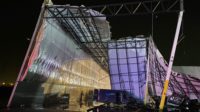Report Shows Chicagoland Shopping Center Development has Dropped 79% in Last Two Years
For the second consecutive year, the sluggish U.S. economy has slowed development of new shopping centers in Chicagoland, according to an annual survey by Mid-America Real Estate Corporation, Oakbrook Terrace, Ill.
The Mid-America 2009-10 Shopping Center Report, released in January, shows that delivery of gross leasable area (GLA) for new Chicagoland shopping centers totaled 1.7 million sq ft in 2009, down 53% from 3.7 million sq ft. in 2008.
When compared to the record-breaking 8.4 million sq ft of new space in 2007, the total GLA for 2009 dropped 79% in the past two years.
The survey’s author, Mid-America Senior Vice President Andy Bulson, says this is the steepest drop in new shopping center development since the report began in 1983, and the lowest total GLA for new space since 1984.
“Financing difficulties and lagging retail demand have plagued most of the projects,” says Bulson. In addition, due to over-expansion of chain stores during previous years, retailers are building on existing networks and absorbing vacant boxes, rather than driving ground-up development. “We are also seeing a lack of new big-box retail concepts entering the market,” he adds.
Bulson says that more than half of 2009’s development came from self-development by Wal-Mart, Menard’s and Costco, which are expected to continue at the same level in coming years. Wal-Mart opened two new supercenters in outlying areas. Menard’s opened two new stores. Target, Lowes, and Costco each opened one.
However, he says that power center development remained largely on hold in metro Chicago, with Hillside Town Center being the only traditional multiple-anchor power center opening in 2009. In addition, two mixed-use urban projects, Block 37 and Roosevelt Collection, partially opened in 2009, and will continue to move forward.
In the suburbs, says Bulson, inactivity for new shopping centers has been especially pronounced. And, as in the city, most ground-up power center development that was scheduled to open in 2009 has been stalled.
Bulson’s report says that with only 1.7 million sq ft of new GLA expected to open this year, 2010 could rival 2009 as the lowest for new shopping center growth since 1984.
He expects no traditional multiple-anchor power centers to open in 2010. However, national discounters and grocers will continue to lead in developing new space. Costco will open two new locations that have been in the works for years: one in Bolingbrook, the other in Melrose Park.
“We hope to see this downturn bottom out in 2010 and pick up marginally in 2011,” says Bulson. “But that would require that unemployment does not worsen, the housing market continues to stabilize, consumer spending increases, existing vacancy is absorbed, and lending return to the commercial real estate sector.”
On a positive note, Bulson says that now is a good time for retailers to grab good spots in high-priority markets. “If you’ve got a good concept or you’re a rent-sensitive national retailer, it’s a good time to take advantage of the lower rents in the prime locations,” he advises.
Bulson says big box category killers are already modifying typical deal structures and traditional store formats to take over vacant boxes in densely populated areas and surrounding collar communities — the smaller urban markets they couldn’t get into before.


